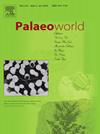Palynological assemblages from Hongguleleng Formation of Western Junggar, Northwest China and their correlation with conodont zonation
IF 1.7
3区 地球科学
Q2 PALEONTOLOGY
引用次数: 0
Abstract
The Upper Devonian Hongguleleng Formation is a significant stratigraphic unit near the Frasnian/Famennian and Devonian/Carboniferous boundaries of the Kazakhstan Paleoplate. However, its age is still under debate. A new palynostratigraphic analysis was conducted at the Gennaren section to provide a more accurate biostratigraphic assignment. In this study, we identified 43 species belonging to 26 spore genera, including those in open nomenclature. Despite the poor preservation of the palynofloras, the spore taxa were categorized into two assemblages. Assemblage I is established at the lower part of the lower member of the Hongguleleng Formation, containing Cornispora varicornata, cf. Auroraspora pseudocrista, and Cyrtospora cristifera. Assemblage II is from the upper part of the lower member of the Hongguleleng Formation, including Grandispora cornuta, Grandispora famennensis var. famennensis, Grandispora cf. famennensis var. minutus, Grandispora microseta, and Rugospora radiata. These assemblages are compared with the Western European DV Oppel Zone (lower-middle Famennian), and the GF to VCo Oppel zones. The assemblages are equivalent to the conodont crepida–rhomboidea and marginifera to Lower trachytera zones (middle-upper Famennian).
中国西北准噶尔西部红古楞地层的古生物组合及其与锥齿动物分带的相关性
泥盆纪上统红古楞地层是哈萨克斯坦古地层中靠近弗拉斯年/法门年和泥盆纪/石炭纪边界的一个重要地层单元。然而,其年龄仍存在争议。为了提供更准确的生物地层划分,我们在 Gennaren 剖面进行了新的古地层分析。在这项研究中,我们确定了属于 26 个孢粉属的 43 个物种,其中包括那些开放命名的物种。尽管古植物保存较差,但我们还是将孢子类群分为两个集合体。组合 I 位于红古楞地层下部,包含 、 、 和 。组合 II 位于红古楞地层下统的上部,包括Ⅴ变种、Ⅴ变种、Ⅴ变种和Ⅴ变种。这些组合与西欧 DV 奥佩尔带(法门年中下期)以及 GF 至 VCo 奥佩尔带进行了比较。这些化石群与同牙- 和下区(法门纪中上叶)相当。
本文章由计算机程序翻译,如有差异,请以英文原文为准。
求助全文
约1分钟内获得全文
求助全文
来源期刊

Palaeoworld
PALEONTOLOGY-
CiteScore
4.00
自引率
5.90%
发文量
95
期刊介绍:
Palaeoworld is a peer-reviewed quarterly journal dedicated to the study of past life and its environment. We encourage submission of original manuscripts on all aspects of palaeontology and stratigraphy, comparisons of regional and global data in time and space, and results generated by interdisciplinary investigations in related fields. Some issues will be devoted entirely to a special theme whereas others will be composed of contributed articles. Palaeoworld is dedicated to serving a broad spectrum of geoscientists and palaeobiologists as well as serving as a resource for students in fields as diverse as palaeobiology, evolutionary biology, taxonomy and phylogeny, geobiology, historical geology, and palaeoenvironment.
Palaeoworld publishes original articles in the following areas:
•Phylogeny and taxonomic studies of all fossil groups
•Biostratigraphy, chemostratigraphy, chronostratigraphy
•Palaeoecology, palaeoenvironment and global changes throughout Earth history
•Tempo and mode of biological evolution
•Biological events in Earth history (e.g., extinctions, radiations)
•Ecosystem evolution
•Geobiology and molecular palaeobiology
•Palaeontological and stratigraphic methods
•Interdisciplinary studies focusing on fossils and strata
 求助内容:
求助内容: 应助结果提醒方式:
应助结果提醒方式:


